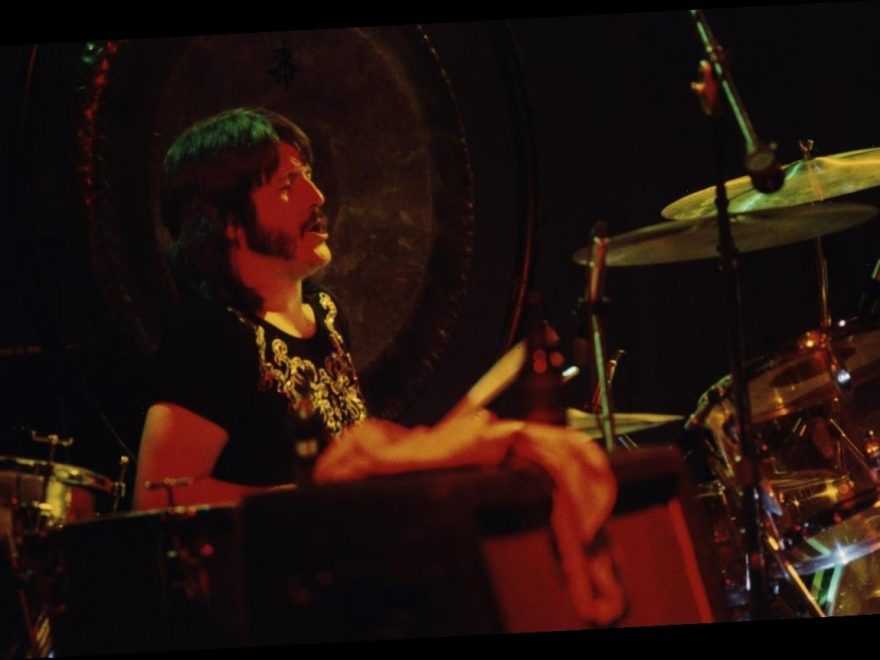Would Led Zeppelin have continued beyond 1979’s In Through the Out Door? No one can say, but it’s clear there were storm clouds on Zep’s horizon nearing the dawn of the new decade. Looking back on the recording, bassist-keyboardist John Paul Jones recalled the band splintering into two camps during these sessions.
On the one side, you had Jones and Robert Plant, who brought their usual energy (if not more) to the late ’78 sessions for In Through the Out Door. For the first time in the band’s history, listeners found Zep songs credited to only Jones and Plant on this album.
In the other camp, you had two forces of nature: Jimmy Page and John Bonham. The substance abuse of Bonham (alcohol) and Page (harder drugs) pushed the rock heavyweights into more of a supporting role than they’d had on previous Zep albums. And you can hear it in the rcord’s softer feel.
But you couldn’t keep musicians like Bonham and Page from summoning their powers once the tape started rolling. And on one surprising, samba-infused In Through the Out Door track both Zep giants joined Jones and Plant in delivering a highlight of the band’s final statement.
Led Zeppelin got a samba groove going midway through ‘Fool in the Rain’

RELATED: Who Led Zeppelin’s John Bonham Considered a True Pioneer Among Rock Drummers
After breaking onto the scene with its dazzling mix of heavy rock and folk (sometimes in the same track), Led Zeppelin showed it would never sit tight and follow a market-tested formula. That’s how you got the curveball of a third album the band released in 1970.
By Houses of the Holy (1973), fans had probably braced themselves for the turns toward funk and reggae the group took on its follow-up to the monumental fourth album. As the ’70s wore on, Page and his bandmates would give fans soft rock, rockabilly, and country in addition to expected excursions into progressive rock and proto-metal.
But after the very metal Presence (1976) no one could have predicted Zep would take a stab at Latin-influenced tracks like “South Bound Saurez” and “Fool in the Rain.” These In Through the Out Door cuts hint of the more prominent role Jones played in the record. (Jones and Plant reportedly got the idea for the track watching the 1978 World Cup in Argentina.)
And on “Fool in the Rain” the oddest thing happens about two-and-a-half minutes in: Led Zeppelin dives headlong into a samba break powered by Bonham. After Jones established the Latin groove and Bonham laid down a beat for the ages, the whistles came out for a Zep-style trip to carnaval.
John Bonham shines on timbales and agogo bells, among other percussion instruments

If Bonham had stopped with the main groove he dropped on “Fool in the Rain,” he would have delivered one of his finest moments on record. However, with the work he does on the Brazilian samba section, Bonham takes his percussion work to another level.
Zeppelin fans who’ve seen Bonham perform “Moby Dick” live know he felt comfortable with multiple types of percussion instruments. And he proves that when he uses timbales, agogo bells, and possibly the marimba during the “Fool in the Rain” middle section. When people say no one ever matched Bonham, they’re talking about moments like this one.
But Page shines about as brightly as Bonzo here. After a return to the main theme, Page takes a magnificent guitar solo (at 3:51) that lasts longer than a full minute. The distorted, unique sound came courtesy of an Octivider effects box that sends out notes at multiple octaves simultaneously.
In brief, Led Zeppelin made samba fit within the band’s eclectic style. And though Page thought it worked fine on In Through the Out Door, he spoke of how he and Bonham hungered for a heavier follow-up for Zep in the ’80s. Sadly, they never got the chance.
RELATED: Why Led Zeppelin’s ‘All My Love’ Didn’t Sit Right With Jimmy Page
Source: Read Full Article
